Overview
- Brief Narrative
- Red inverted triangle badge imprinted with KL Dachau and prisoner number 15611 acquired by Arthur List at an unknown date. Arthur, 22, (then Adolf Lustgarten) was liberated in April 1945 while an inmate at Dachau with the prisoner number 159831. The badge resembles the patches prisoners had to wear on their uniforms. In September 1939, Poland was occupied by Nazi Germany. Around 1941-42, Adolf was picked up off the streets in Wadowice to do forced labor. He was eventually sent to Gross Rosen concentration camp and then to slave labor subcamps. Circa 1943 or later, he was transferred to Flossenbürg concentration camp, and assigned to Hersbruck labor camp to build underground tunnels. In April 1945, as Allied forces approached, the camp was evacuated and Adolf was sent on a death march to Dachau and liberated. His mother and sisters were sent to Auschwitz in 1943 where it is presumed they were killed. Arthur emigrated to the United States in December 1946.
- Date
-
unavailable:
- Credit Line
- United States Holocaust Memorial Museum Collection, Gift of the family of Arthur List
- Contributor
-
Subject:
Arthur R. List
- Biography
-
Adolf Lustgard (or Lustgarten] (later Arthur Robert List) was born on April 23, 1923, to Herman and Ida Wulkan Lustgarten, in Goerlitz, Germany, on the border with Poland. Ida was born in 1900 in Zywiec, Poland. Herman was born in 1898 in Nowy Sacz, Poland. The family was observant and spoke Polish and Yiddish at home. In 1933, the Nazi dictatorship took power in Germany. Persecution of the Jewish population became government policy and grew increasingly harsh. In 1938, Adolf and his family, including his sisters, were deported to Poland, where his parents were born. They settled in Wadowice. At some point, Arthur's father Herman, along with two of his brothers, emigrated to Palestine.
On September 1, 1939, Nazi Germany invaded Poland. Adolf went to Germany, with papers that listed his birthdate as 1928, thinking the younger age might help him to get work. In 1940, he was back in Wadowice where he was taken off the streets to be a forced laborer around 1941-42. Arthur had taken some family photographs with him. In one of the work camps, he and another friend, who also had photos, heard the camp was going to be closed and they decided to hide their photos. They put them in an empty tea box Arthur had saved and Arthur's friend lowered him into the latrine and he buried them. Arthur was eventually sent to Gross Rosen concentration camp and then to slave labor subcamps in Oppeln and Langenbielau. At each camp, conditions got worse. Hunger became so severe that it was all Arthur could think about. Circa February 1943, he was transferred to Flossenbürg concentration camp in Germany and was assigned prisoner number 85210. He worked constructing bridges for the autobahn. He was then sent to Hersbruck satellite camp, where they were building underground tunnels for a planned BMW aircraft factory. On April 24, 1945, Adolf was sent by transport and a nearly 100 mile death march to Dachau concentration camp. Prisoners who could not keep up were shot along the the way. He was assigned prisoner number 159831. He was liberated a few days later, ca. April 28, by US troops. Adolf was just skn and bone and very ill. One of the liberators gave him a mezuzah, thinking he was not going to make it. Adolf saved it and later was buried with it.
By June 1945, Adolf was living at Neu Freimann displaced persons camp near Munich. He knew some English, in addition to German, Polish, and Yiddish, and assisted the occupation authorities with interviews and interrogations. His mother and two sisters had been transported in 1943 from Wadowice to Auschwitz concentration camp where it is presumed they perished. His stepfather survived and emigrated to the United States. Adolf's friend from the early work camp survived and recovered the photographs they had hidden. In 1946, Arthur was able to leave for the US with the assistance of Carl Tipograff(?), a US soldier. He sailed on the Marine Marlin from Bremen and arrived in New York on December 20, 1946. He changed his name to Arthur Robert List, married, and had three children. Arthur, age 86, passed away on November 30, 2009, in New York.
Physical Details
- Language
- English
- Classification
-
Identifying Artifacts
- Category
-
Badges
- Object Type
-
Badges (lcsh)
- Physical Description
- Small, inverted, black plastic triangle with a recessed red painted inverted triangle within a white border on the front. German text and a prisoner number 15611 are etched across the widened top edge. There is a small hole in each triangle point.
- Dimensions
- overall: Height: 1.375 inches (3.493 cm) | Width: 1.250 inches (3.175 cm)
- Materials
- overall : plastic, paint
- Inscription
- front, etched : K L Dachau 15611
Rights & Restrictions
- Conditions on Access
- No restrictions on access
- Conditions on Use
- No restrictions on use
Keywords & Subjects
Administrative Notes
- Legal Status
- Permanent Collection
- Provenance
- The badge was donated to the United States Holocaust Memorial Museum in 2012 by the family of Arthur List.
- Funding Note
- The cataloging of this artifact has been supported by a grant from the Conference on Jewish Material Claims Against Germany.
- Record last modified:
- 2023-12-08 11:37:39
- This page:
- https://collections.ushmm.org/search/catalog/irn73635
Download & Licensing
In-Person Research
- By Appointment
- Request 21 Days in Advance of Visit
- Plan a Research Visit
- Request to See This Object
Contact Us
Also in Arthur R. List collection
The collection consists of six commemorative triangle badges, documents, and a DVD relating to the experiences of Adolf Lustgarten (later Arthur Robert List) during the Holocaust, when he was imprisoned in Gross Rosen, Flossenbürg and Dachau concentration camps and subcamps.
Date: approximately 1999-2000
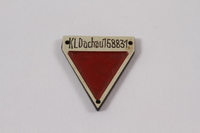
Commemorative red triangle Dachau badge 158831 owned by former inmate
Object
Red inverted triangle badge imprinted with KL Dachau and prisoner number 158831 acquired by Arthur List at an unknown date. Arthur, 22, (then Adolf Lustgarten) was liberated in April 1945 while an inmate at Dachau with the prisoner number 159831. The badge resembles the patches prisoners had to wear on their uniforms. In September 1939, Poland was occupied by Nazi Germany. Around 1941-42, Adolf was picked up off the streets in Wadowice to do forced labor. He was eventually sent to Gross Rosen concentration camp and then to slave labor subcamps. Circa 1943 or later, he was transferred to Flossenbürg concentration camp, and assigned to Hersbruck labor camp to build underground tunnels. In April 1945, as Allied forces approached, the camp was evacuated and Adolf was sent on a death march to Dachau and liberated. His mother and sisters were sent to Auschwitz in 1943 where it is presumed they were killed. Arthur emigrated to the United States in December 1946.
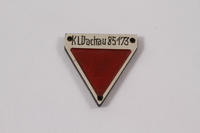
Commemorative red triangle Dachau badge 85173 owned by former inmate
Object
Red inverted triangle badge imprinted with KL Dachau and prisoner number 85173 acquired by Arthur List at an unknown date. Arthur, 22, (then Adolf Lustgarten) was liberated in April 1945 while an inmate at Dachau with the prisoner number 159831. The badge resembles the patches prisoners had to wear on their uniforms. In September 1939, Poland was occupied by Nazi Germany. Around 1941-42, Adolf was picked up off the streets in Wadowice to do forced labor. He was eventually sent to Gross Rosen concentration camp and then to slave labor subcamps. Circa 1943 or later, he was transferred to Flossenbürg concentration camp, and assigned to Hersbruck labor camp to build underground tunnels. In April 1945, as Allied forces approached, the camp was evacuated and Adolf was sent on a death march to Dachau and liberated. His mother and sisters were sent to Auschwitz in 1943 where it is presumed they were killed. Arthur emigrated to the United States in December 1946.
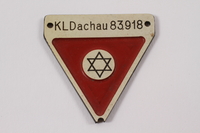
Commemorative red triangle Dachau badge 83918 owned by former camp inmate
Object
Red inverted triangle badge imprinted with KL Dachau, prisoner number 83918, and a Star of David acquired by Arthur List at an unknown date. Arthur, 22, (then Adolf Lustgarten) was liberated in April 1945 while an inmate at Dachau with the prisoner number 159831. The badge resembles the patches prisoners had to wear on their uniforms. In September 1939, Poland was occupied by Nazi Germany. Around 1941-42, Adolf was picked up off the streets in Wadowice to do forced labor. He was eventually sent to Gross Rosen concentration camp and then to slave labor subcamps. Circa 1943 or later, he was transferred to Flossenbürg concentration camp, and assigned to Hersbruck labor camp to build underground tunnels. In April 1945, as Allied forces approached, the camp was evacuated and Adolf was sent on a death march to Dachau and liberated. His mother and sisters were sent to Auschwitz in 1943 where it is presumed they were killed. Arthur emigrated to the United States in December 1946.
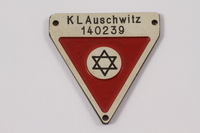
Commemorative red triangle Auschwitz badge 140239 owned by former camp inmate
Object
Red inverted triangle badge imprinted with a Star of David, KL Auschwitz and prisoner number 140239 acquired by Arthur List at an unknown date. Arthur, 22, (then Adolf Lustgarten) was liberated in April 1945 while an inmate at Dachau with the prisoner number 159831. The badge resembles the patches prisoners had to wear on their uniforms. In September 1939, Poland was occupied by Nazi Germany. Around 1941-42, Adolf was picked up off the streets in Wadowice to do forced labor. He was eventually sent to Gross Rosen concentration camp and then to slave labor subcamps. Circa 1943 or later, he was transferred to Flossenbürg concentration camp, and assigned to Hersbruck labor camp to build underground tunnels. In April 1945, as Allied forces approached, the camp was evacuated and Adolf was sent on a death march to Dachau and liberated. His mother and sisters were sent to Auschwitz in 1943 where it is presumed they were killed. Arthur emigrated to the United States in December 1946.
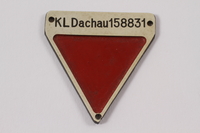
Commemorative red triangle Dachau badge 158831 owned by former inmate
Object
Red inverted triangle badge imprinted with KL Dachau and prisoner number 158831 acquired by Arthur List at an unknown date. Arthur, 22, (then Adolf Lustgarten) was liberated in April 1945 while an inmate at Dachau with the prisoner number 159831. The badge resembles the patches prisoners had to wear on their uniforms. In September 1939, Poland was occupied by Nazi Germany. Around 1941-42, Adolf was picked up off the streets in Wadowice to do forced labor. He was eventually sent to Gross Rosen concentration camp and then to slave labor subcamps. Circa 1943 or later, he was transferred to Flossenbürg concentration camp, and assigned to Hersbruck labor camp to build underground tunnels. In April 1945, as Allied forces approached, the camp was evacuated and Adolf was sent on a death march to Dachau and liberated. His mother and sisters were sent to Auschwitz in 1943 where it is presumed they were killed. Arthur emigrated to the United States in December 1946.
Arthur List papers
Document
Contains postwar identification documents, compact discs of recorded interviews (dated 1999-2000), and copies of letters from schoolchildren (1999), related to Arthur List (born Adolf Lustgarten), and his experiences during and after the Holocaust. List, a native of Görlitz, Germany, was imprisoned in various concentration camps, including Flossenbürg, and immigrated to the United States after the war.



